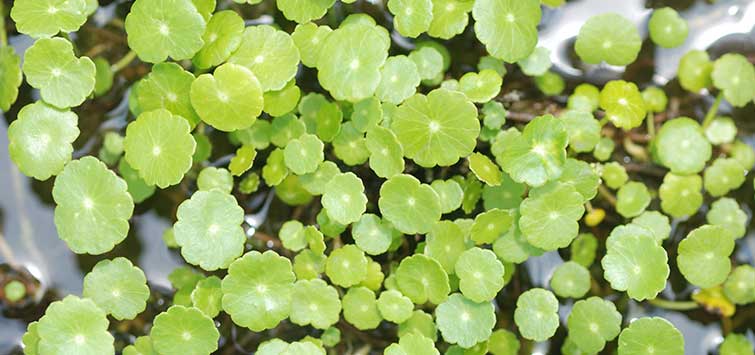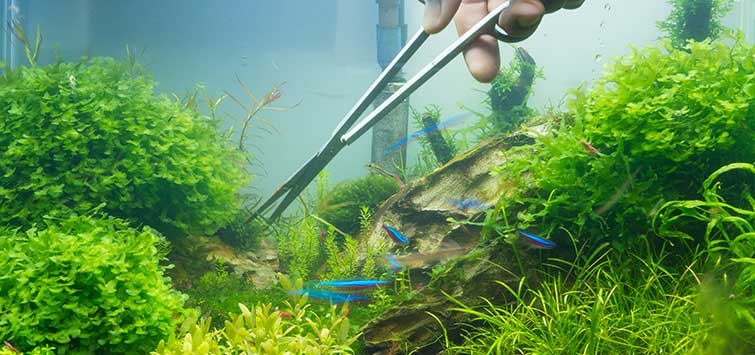Aquarium Lilies
Author: Jonathan Fung
A look at some of the beautiful lilies and lily-like plants for the aquarium, as well as some tips on making them an attractive and functional element in your aquascape.
Lilies and lily-like plants are great for the aquarium. Their broad leaves break up the monotony of vertically oriented stems that are prevalent in most planted tanks. At the same time, they produce many shaded areas within the aquarium that encourage natural activity and behavior in shy fish species. Even the most secretive fishes like the bumblebee catfish Microglanis iheringi and the black ghost knifefish Apteronotus albifrons will forage actively in open view while under the shadows of lily leaves.
There are very few species of lilies that are offered as aquarium plants. While there are no biological reasons why most tropical pond lilies cannot thrive under proper conditions within the aquarium, most simply grow too large. Species of lilies and lily-like plants that are commonly offered as aquarium plants include the banana plant Nymphoides aquatica, the dwarf aquarium lily Nymphaea stellata, Japanese spatterdock Nuphar japonicum, and the tiger lotus lily Nymphaea maculata. These plant species are well suited for the aquarium due to their small sizes.
General Aquarium Lily Care
Lilies and lily-like plants can grow quickly when provided optimal conditions. In general, these plants will benefit from the use of strong lighting and supplemental dissolved carbon dioxide. Aquarium lilies and lily-like plants will reward the hobbyist with noticeably larger leaves soon after these essential improvements have been made.
These species are typically placed as mid-ground to foreground plants, though their aesthetic placement is not as important as making sure they are getting enough light within the aquarium. Meanwhile, they can also create an appealing oasis effect when used as stand-alone individual plantings, somewhat reminiscent of solitary palm trees in the desert.
The maximum height of the lilies and similar plants is often limited only by the water level. These plants send floating leaves to the water surface, and these leaves should be removed and trimmed in the aquarium. This can be performed by cutting the stem near its origin. If left unattended, these leaves will block nearly all light from reaching the understory, causing all submerged leaves and other plants below to die. Old leaves that have become ragged and covered with algae should also be removed. Most of these plant species have extensive lateral roots, and they can benefit from fertilizer tablets designed to be buried near plant roots for nutrient uptake. This mode of fertilizer use is especially useful to provide chelated iron, a nutrient that helps the development of pigments.
Types of Aquarium Lilies
Tiger Lotus Lily (Nymphaea maculate)
The tiger lotus lily Nymphaea maculata is a slightly larger species of lily that is sometimes offered as an aquarium lily due to its colorful appeal. This species is usually more difficult to find than the other aquarium lilies, primarily because only specialty retailers care to stock it due to its relatively high wholesale price. However, tiger lotus lily is frequently available from domestic distributors throughout the year, and most retailers should be able to order this plant by request. Despite its size, the tiger lotus lily is still a great candidate as an aquarium plant if kept trimmed.
The tiger lotus lily is indigenous to West Africa. This plant can tolerate a wide range of temperatures (70° to 85°F), pH values (5 to 8), and water hardness (though soft is ideal). Under ideal growing conditions, its round leaves can reach 6 inches in diameter. This species bears white colored flowers that are approximately 2½ inches in diameter.
Tiger lotus lily is commonly offered as red tiger lotus lily or green tiger lotus lily. Both forms have dark red patterns upon their leaves with purple undersides, but they differ from one another in that one variety has red leaves and the other has green leaves. Interestingly, however, green tiger lotus lily may turn red, and some red tiger lotus lily leaves appear green when newly grown. Thus, there is probably no definitive separation between the two varieties, perhaps differing only by the conditions in which they were grown prior to acquisition.
Note that when purchasing this plant, tiger lotus lily may or may not be sold while attached to a bulb. This bulb is the seed from which it had germinated and attachment to it is not necessary for its survival.
Dwarf Aquarium Lily (Nymphaea stellate)
The dwarf aquarium lily is indigenous to India and Sri Lanka, and it is one of the most commonly available species of lilies available in the aquarium industry. New specimens are usually attached to the bulb from which they germinated, though bulb attachment is not necessary for survival.
The elongated arrow-shaped leaves of N. stellata are typically narrow when they are small, but they broaden in width as they grow. Surface lily leaves grown under sunlight can reach a diameter of 12 inches, though submersed leaves rarely exceed 4 inches in diameter. The leaves are usually greenish brown or reddish brown in color. This lily naturally occurs in soft water, but it can also tolerate a wide range of parameters (71° to 83°F, pH 5 to 8). Flowers of this lily can be red or blue in color.
Banana Plant(Nymphoides aquatic)
Banana plants are also commonly available to the aquarium trade. They are native to the southeastern United States where natural water temperatures range from 64° to 83°F. This species produces heart-shaped leaves that are up to 4 inches in diameter. The leaves are light green to dark green in color, but sometimes a shade of red may appear on the top surface.
The name “banana plant” arose from its tuber structures that resemble a bunch of green bananas. These tubers serve as storage tissues for energy reserves. Bright lighting is required to maintain high growth with this species, but it can also survive through periods of lower lighting due to these energy reserves. When planting this specimen, note that the tuber structures are naturally located aboveground and should not be buried.
Japanese Spatterdock(Nuphar japonicum)
Although commonly available from domestic livestock distributors, Japanese spatterdock Nuphar japonicum is infrequently found in aquarium store inventories due to its high light demand. The Japanese spatterdock will usually perish within weeks of arrival if its high lighting demands are not met. In comparison, retailers can readily sell banana plants or dwarf aquarium lilies—even to inexperienced hobbyists—because they are relatively robust and could stay alive for some time under low lighting.
Japanese spatterdock occurs in Japan and parts of Southeast Asia. Its light green colored leaves are ruffled and elongated, are shaped somewhat like arrows, and can grow up to 6 inches in length. Like the other lilies mentioned above, it can tolerate a wide range of water parameters (pH 5 to 8, soft to hard water, temperature 50° to 83°F). The leaves and roots of this plant grow from a long rhizome that is sometimes up to 1½ inches in thickness.
Lily Propagation
Lilies and lily-like plants are angiosperms, or flowering plants. These plants can produce flowers at the water surface for pollinators to visit and exchange gametes for sexual reproduction. Fertilized flowers develop seeds that readily germinate in the aquarium. Seasonal flowering in plants, however, often requires a simulation of seasonal changes in photoperiod. While sexual reproduction by flowering and cross-pollination may be too complex within the aquarium, lilies and similar plants will readily undergo vegetative propagation under bright lighting and when supplied with supplemental dissolved carbon dioxide.
In the tiger lotus lily and dwarf aquarium lily, vegetative propagation can be observed as stolons (aboveground lateral chutes) that grow away from the parent, from which entire new plants will grow. After some time, the lily may grow into a dense colony. At this point, the colony can be uprooted, and individual plants may be separated and replanted.
Banana plants can be asexually reproduced by vegetative propagation through fragmentation. Pieces of leaf tissues can be torn off and left to float freely within the aquarium. In most cases the leaf fragments will be positively buoyant, and they float about the water surface, during which time the leaf fragments are still living and continue to undergo photosynthesis. Under bright lighting, new plantlets can develop along nodules or torn places along the leaf’s edge. Once the plantlet features recognizable parts with roots, the plantlet can be plucked from the leaf fragment and then planted in the substrate.
When Japanese spatterdock thrives under bright lighting, new plants naturally develop and grow from its long rhizome. Propagation is done by cutting up the rhizome between the origins of individual plants. Note that specimens of this plant are usually acquired with the leaves growing from the very tip of the rhizome. In such cases, it is often easiest to plant the rhizome vertically because it is positively buoyant. Vertically planting rhizomes, however, may discourage the development of new plants due to shading. It is best to plant the rhizome structure horizontally without burying it. This can be done by wedging it into crevices formed by rocks or driftwood, or by the use of various plant weights. Note that any portions of the rhizome that have softened and decayed should be surgically removed to prevent the entire plant from rotting.
Beautiful Lilies Make a Beautiful Aquarium
While many of the better-known lily species grow too large to be aquarium-friendly, there are several lilies that can be beautiful additions to a planted tank layout, adding both aesthetic interest and functioning as shade plants to bring shy or reclusive fish species out into the open. The lily species presented above, if provided high enough levels of lighting, supplemental CO2, and adequate fertilization, make hardy and often breathtaking aquarium plants that can lend striking accents to just about any planted aquascape.

.png?h=595&iar=0&w=2781&hash=5FD5E69473BCC22199FBFA2FB71B6033)



